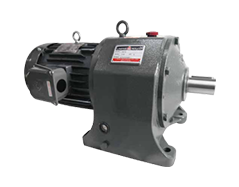
2021-06-03
There are five common problems with the gears of the bevel gear reducer:
1. Tooth surface wear; 2. Tooth surface glued; 3. Fatigue pitting; 4. Tooth surface plastic deformation; 5. Gear is broken. For open gear transmission or closed gear transmission containing dirty lubricating oil, due to the relative sliding between the meshing tooth surfaces, some hard abrasive particles enter the friction surface, which changes the tooth profile, increases the tooth gap, and makes the gear excessively change. Thin, causing broken teeth.
Under normal circumstances, only abrasive particles mixed into the lubricating oil will cause tooth surface wear during operation. In the high-speed and heavy-duty gear transmission of the bevel gear reducer, due to the high friction between the tooth surfaces, the relative speed is high, and the temperature in the meshing zone is too high. Once the lubrication condition is not good, the oil film between the tooth surfaces will disappear, and the metal surfaces of the two gear teeth will directly contact, resulting in mutual adhesion. When the two tooth surfaces continue to move relative to each other, the harder tooth surface tears part of the material on the softer tooth surface along the sliding direction to form a groove.
When the two meshing gears of the bevel gear reducer are in contact, the force and reaction force between the tooth surfaces produce contact stress on the two working surfaces. As the position of the meshing point changes, the gear moves periodically, and the contact stress changes according to the pulse period. Under the action of this long-term alternating contact stress, small cracks will appear at the knife marks on the tooth surface. With the passage of time, the cracks of the bevel gear reducer gradually spread laterally on the surface. After the cracks form a ring, a small area of the tooth surface will peel off, forming some shallow fatigue pits.
The gear that bears the load in the operation project is like a cantilever beam. When the pulse cycle stress at the tooth root of the bevel gear reducer exceeds the fatigue limit of the gear material, cracks will occur at the tooth root and gradually expand, and the remaining part will fail to bear the transmission load.
The gears of the bevel gear reducer may also cause tooth breakage due to severe impact, unbalanced load and uneven materials. Under the action of impact load or heavy load, the tooth surface is prone to local plastic deformation, resulting in the deformation of the involute tooth profile surface.
